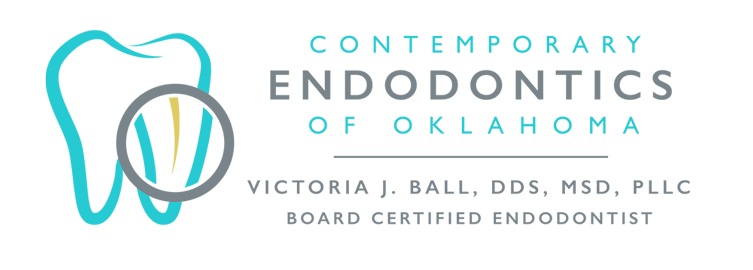Root Resorption in Edmond, OK
Contemporary Endodontics provides root resorption to patients in Edmond, OK. Contact us at 405-285-5042 to learn more or schedule an appointment.
Root resorption occurs when the roots of a tooth start to weaken and dissolve. This occurs naturally when children lose their baby teeth as the permanent teeth come in. But when it happens in adulthood to a permanent tooth it is not normal and needs to be addressed.
Symptoms
It is not always obvious that root resorption is occurring. Common symptoms include:
- No pain (most of the time, teeth with resorption look and seem fine)
- Tooth pain
- Loose teeth
- Swollen or red gums
- Pink or dark spots on teeth
- Shifting teeth
Potential Causes
There are a few potential causes of root resorption in permanent teeth:
- Trauma. Any type of trauma to the face or teeth from sports injuries, car accidents, etc. can trigger resorption to occur.
- Infection. An infection of the gums or a nerve can lead to root resorption. The real cause is the inflammation that occurs as a result of the infection.
- Impacted teeth. When a permanent tooth pushes against the roots of another permanent tooth, such as what is common with wisdom teeth that don’t come in properly, it can cause root resorption.
- Teeth grinding. If you chronically grind your teeth, the pressure it exerts on your teeth and their support structures can cause the roots to break down.
- Movement of teeth. When teeth shift out of their proper position, such as with orthodontic treatment or due to a missing tooth, root resorption can occur.
Sometimes the cause is unknown, but regardless of the cause, the condition needs to be treated as soon as possible to prevent loss of teeth.
Treatment
Treatment for root resorption varies greatly based on the assumed cause. Any of the following treatments may be used:
- Root canal. Sometimes a tooth can be saved with a root canal. In this procedure the inner portion of the tooth is removed and filled. Any damaged root tissue will be patched. A crown may need to be placed as part of a root canal.
- No Treatment. In some cases, the area the resorption is located may not be treatable and the tooth may need to be monitored until it becomes more severe or until symptoms develop and then it would require extraction.
- Extraction. In some cases the root resorption is so advanced that the tooth can’t be saved. It will need to be extracted and replaced with a dental implant or bridge.
Diagnosis
Early diagnosis is a key factor in stopping root resorption and saving the tooth. Regular dental exams with yearly X-Rays is the best way to catch this condition early and provide adequate treatment. If the condition persists without treatment, there is a greater chance the tooth will need to be extracted and replaced. Going to the dentist on a recommended schedule (every 6 months) will greatly increase your chances of keeping your permanent teeth in place.
Frequently Asked Questions
Why does root resorption occur?
As stated above, there are a few possible causes, but sometimes the cause is unknown. Trauma is the most common cause. Inflammation due to infection, impacted teeth, chronic teeth grinding, and movement of your teeth are some other reasons.
Can root resorption be prevented?
There’s no definite way to prevent root resorption. The most important thing you can do is wear a sports guard when playing any type of sport. Good oral hygiene and regular check ups with your general dentist can help identify issues early on. Call your dentist if you experience any pain, discomfort, or unusual symptoms.
Is it better to treat the tooth or have it pulled?
We always recommend treatment over extraction for a variety of reasons. For one, treatment is almost always less expensive than a replacement tooth. And it is always in your best interest to replace the tooth rather than leave an empty space. Your other teeth may shift into the space left by the extracted tooth and cause root resorption in those teeth, as well as other dental issues.
Contact us at 405-285-5042 to schedule an appointment.
